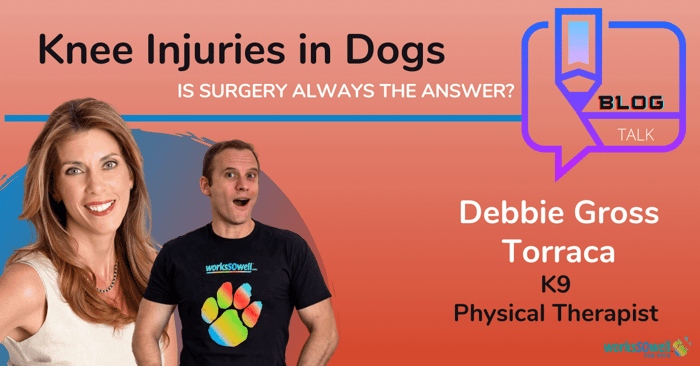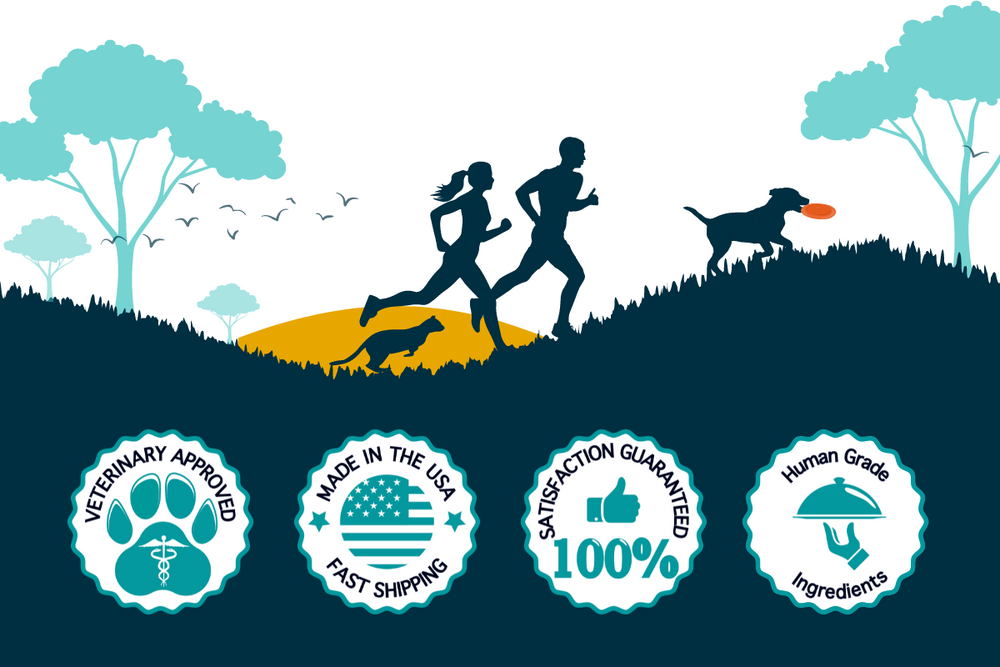Knee Injuries in Dogs: Is Surgery Always the Answer?
Knee Injuries in Dogs: Is Surgery Always the Answer? If your dog has ever started limping in pain or even become lame, seeing your dog suffering and not even knowing the cause or the solution is heart-wrenching. A year ago, I was in that position with my little Sacha and turned to the experts for answers. I am thrilled to bring you real expert answers from one of my dear friends, Dr. Torraca, DPT, MSPT, CCRP, CCMT, Board-Certified Orthopedic Clinical Specialist. She will share her expert insights on five key points on K9 knee care while answering burning questions like, “Does my dog need knee surgery?” and “What are some simple things to do for the conservative cruciate case?”
What below the full live interview:
Introduction to Debbie
Dr. Torraca is a physical therapist who owns a clinic, Wizard of Paws, where every day, she tries to talk clients off the ledge in terms of making their dogs through surgery for something as simple as a limp. She is all about conservative care.
Dr. Torraca has been a physical therapist for over 30 years. She’s been working with small animals for almost 25 years. Her philosophy is “the best quality of life for the longest time possible.”
They try to avoid surgery at all costs in their clinic. Coming from the human background, they will try conservative measures before cutting. Same with dogs. So many owners are rushed into surgery. You can always cut, but you can’t uncut. If you look at reducing pain and inflammation and improving strength, there are so many things to do before surgery.
The Ins and Outs of Conservative Care in Treating Cruciate Disease
● Cruciate disease is super common. Predisposing factors include the age, if they have been spayed or neutered, weight, and the breed of dog. A spayed slightly overweight Labrador retriever is at higher risk for a cranial cruciate tear.
● A person will tear their ACL or cruciate acutely, more abruptly. In a dog, it’s more of a chronic issue that gets worse over time. If you think about the strands of the ligament together like two paintbrushes, an initial tear creates some instability in the knee. They run around and play more, and another one tears. Another strand goes. And another. It’s been going on for a while. Then the dog does something crazy and pulls up lame.
● If a dog tears one side, they have a 40-60% chance of tearing the other side due to overcompensation. When they look at rehabbing, they address both knees as a result.
● Dogs are so good at hiding their pain from humans because they want to put on a brave face for both of us. If you’re not putting all the weight on your leg, you’re hurting. Dogs are the same. Even with those micro-tears, there is some degree of pain. When there is pain, muscles weaken, becoming more painful. It’s a vicious cycle.
● Dr. Torraca uses the multimodal approach. First, they want to decrease pain and inflammation. What tools do they have at their disposal? For decreasing pain, there are so many options from pharmaceuticals to laser to an Assisi Loop, to looking at 1-TDC. All of these options will promote healthy anti-inflammatory factors. Ice is also one of the best anti-inflammatories.
● You also want to improve function. Most of us have experienced twisted ankles (perhaps through one too many cocktails). Those ligaments never come back as strong; that twist will haunt you for the rest of your life unless you work on balance exercises. The goal is to try to get some stability there.
● There are dealbreakers though. If the dog is in too much pain or has a meniscal tear, the knee will not heal. There is also a modification of lifestyle temporarily. No chasing squirrels or balls or Frisbees. No putting additional stress on that knee. If you’re having issues controlling your dog in this way before surgery, good luck doing so after surgery.
● A conservative care plan continues with gradually strengthening the dog. They would do various things such as laser, an underwater treadmill, and lots of other therapeutic exercises in their clinic. At home for the dog, Dr. Torraca emphasizes movement is quality over quantity. If the dog is limping, assume pain.
● Walks are great but try to avoid downhill in the initial phases because that puts a lot of stress on the knee. So do stairs. If you can’t avoid stairs, minimize it and slow it down. If you have to go down a hill, zigzag it. If dogs are tired 4-6 hours after your activity, that’s legal. If they are tired longer than that, that’s illegal; you did too much.
● As a dog owner of a dog with cruciate disease, you have a lot of homework. Walking really is great; you can do that twice a day, quality over quantity. Some dogs can go three miles, and others can go five minutes.
● The other thing is lots of balance exercises. Having the dog stand up while looking up will work on their rear. If you are a kibble feeder, take 10 pieces of kibble out before feeding their dog and hand-feed them while having them look up to transfer that weight. Teaching your dog to walk backwards is a great exercise to engage their hamstrings and gluteals. Having a dog balance on unstable surfaces is a great strengthener, too.
● The big thing is control. Controlling them 50% of the time is okay. Preventing downward movement like sliding on hardwood or tile floors or jumping off of furniture is key.
● Dr. Torraca always advises watching their weight. Reduced activity means you have to reduce their food intake as well since weight is a contributing factor to the impact of cruciate disease. It’s a balance of making sure they get enough protein to increase their muscle mass. You can take a tape measure to measure around their stomach to make sure they aren’t plumping up; you’re looking at their waste measurements.
● Dogs normally put 60-70% of their weight on their front legs, so it can be hard to tell if a dog is limping or not. A trick is to put some red nail polish on the tops and bottoms of the dog’s nails. Wait 24 hours and look and see if they are evenly worn out or not.
● As the dog starts to feel better, you will see less limping, more movement, and more energy. Dr. Torraca likes owners to keep track of their walks. Keep track of time and distance. As they progress, keep track of that, too. And if they regress, that’s okay. There are always minor setbacks on the road to recovery. Debbie experienced that with her own personal knee surgery. Rest is important as you continue to move forward.
● Dr. Torraca does notice that weather can bother dogs the way humans with joint injuries are impacted by the weather. With lots of humidity in the air, inflammation is not going into the environment, so it’s important to respect that. Debbie’s knee hurts in these situations, and she notices it with arthritic dogs, too.
● Dr. Torraca's clinic uses 1-TDC as a topical supplement. She highly recommends it. Another thing she recommends is a brace, but not all dogs will do well with it. I still use one (Go Hero Brace) with Sacha even though she has completely recovered. Braces are also not one size fits all, so be careful. Braces help minimize the movement in the knee and lets the body begin to strengthen. Once the dog is really healing, then wean them off the brace. The brace will help prevent more stress on the knee when running.
Contact Dr. Torraca
● Wizard of Paws on Facebook, Instagram
Additional Resources
● 1-TDC









